Hyundai adds Veloster Turbo, Elantra Coupe and GT
By John Gilbert
SAN DIEGO, CA. — Hyundai has introduced so many impressive new vehicles in the last two years, you’d think the Korean auto-maker deserves to sit back and enjoy the rewards for a while. Instead, Hyundai is adding to its impressive array.
Since the 2011 Sonata, which thrust the company into the spotlight, two of the more interesting vehicles from Hyundai are the compact Elantra, which resembles a downsized Sonata and is such a coordinated and polished car it won the 2012 North American Car of the Year award, plus the unique and sporty Veloster, a three-door hatchback with sporty coupe flair and an accessible rear seat through a second passenger-side door.
Both the Elantra and Veloster were introduced as 2012 models. The Elantra as a remake of a car that was never an ugly duckling but was transformed into the automotive version of a stylish swan, while the Veloster is an all-new model. The Elantra more than delivered on its promise while rewriting the style and feature rules for compacts and also getting 40 miles per gallon. The Veloster was fun, but it promised performance that its high-tech and rev-able 1.6-liter engine had trouble delivering.
With both cars in their introductory year, Hyundai gathered the North American auto media at Torrey Pines, the plush resort in La Jolla, Calif., right near Hyundai’s U.S. corporate offices and design center, to unveil three new versions of the two cars — a turbocharged Veloster, and both a coupe and a five-door, wagon-like model of the Elantra.
The Veloster, Hyundai admitted, was a little shy on power. The 1.6 from the new Accent is a high-tech little jewel, with gas-direct-injection and variable valve-timing, and it is more than adequate for most consumers and most circumstances. But in the Veloster, if it is going to challenge such sporty icons as the GTI, Civic Si, Mini Cooper S, and Beetle Turbo, all of which slap a permanent smile onto the face of anyone driving them, more punch was needed. Hyundai responds promptly when it decides public reaction warrants it, and a twin-scroll turbocharger was the remedy.
A normal, single-scroll turbo picks off some of the exhaust flow headed out the tailpipe and redirects it to spin a turbine-wheel that sends a greater charge of air-fuel mixture back into the engine for improved burning and power. The system works, although there are some minor problems with varying exhaust pulses from different cylinders, which can increase back-pressure and heat and produce uneven airflow back into the cylinders. A twin-scroll turbo has two inlets in the turbine housing, separating the variant exhaust flow and minimizing back-pressure and creating a more pure and dense consistency to the forced-air feed going back into the cylinders. Read more
Lexus adds luxury, and hybrid, to 2013 ES
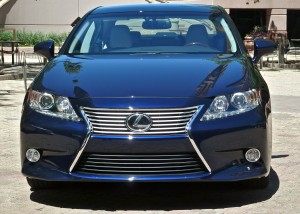
New "spindle" grille sets off totally restyled 2013 Lexus ES sedans, consisting of the 350 and the 300h hybrid.
By John Gilbert
A couple of definitive terms come to mind after first examining the 2013 Lexus ES 350 — Low-key luxury, and quiet competence.
Therein lies the main asset of all things Lexus, and simultaneously what some critics might call the main liability. The beauty of almost all Lexus sedans or SUVs is that they fulfill all expectations rather than trying to set themselves apart with quirky design tricks. In an era when many companies are trying to find uniqueness in their styling, Lexus, and its parent Toyota, have stayed with the formula that has allowed them to strike it rich beyond reasonable bounds — building cars that satisfy, more than surprise.
When Lexus first brought out its luxury LS flagship, the company realized it needed something more of an entry-level attraction as well. The ES was born in 1989, and as one of the originators of what later became the “entry luxury” segment, the front-wheel-drive ES was pretty much a gussied-up Toyota Camry. Lexus officials, however, pointed out over 100 modifications that separated the ES above the garden-variety Camry, and collectively, they justified a larger price tag. The ES 250 was from 1989-91; the ES 300 was 1992-96; the ES 300 was joined by the ES 330 for the 2002-06 run; and the fifth generation was the ES 350 from 2007-12.
For 2013, it’s time for the sixth generation ES, and comes as both the ES 350 and ES 300H — its first hybrid. Chief designer was Toshio Asahi, who spent five years helping design the latest Lexus LS luxury flagship, so he applied a more luxurious look to the ES. The ES has smoothly flowing lines, with a decidedly sportier-looking front end. Lexus calls it a “spindle” grille, which is something of a modified hourglass shape, tapering from a wide upper opening to a narrower middle, then widening again below the bumper from the front fascia. It is similar to the look of the much more sporty and aggressive GS, and the LX SUV, and signals a signature look for future Lexuses (Lexi?).
The new ES is an inch longer with a two-inch longer wheelbase, and the steeply sloped “A” pillar at the front of the doors, as well as the underside, have been reworked for optimum aerodynamics. The ES has a coefficient of drag of only 0.27, where anything under 0.35 is impressive.
Lexus models have proliferated in the 24 years since the ES first came on the scene. The LS luxury flagship remains, with the ES joined by the high-economy CT 200h, and the sportier GS and IS, with “F-Sport” versions, which lend more sportiness to three different lines. The GS and ES are nearly the same size, but with the GS and IS are rear-wheel-drive — unless you choose the all-wheel-drive GS version — while the ES remains front-wheel drive, a definite benefit to consumers where winter weather can be challenging. A couple of SUVs round out the Lexus stable — including the RX, the popular crossover which is due for revision this summer.
As it has risen in sophistication, the ES is the top-selling car in the Lexus fleet, with 38,533 sold in 2011, a year when total Lexus sales were limited to 200,000 by the earthquake and accompanying tsunami that battered Japan in March of 2011, with projections for 2012 topping 250,000.
As if getting a reward, the ES gets a unique platform for 2013, although the upcoming Toyota Avalon will share the same underpinnings, meaning both cars that spun off as fancy and elongated versions of the Camry will now have their own platform. The new ES 350 price is expected to stay close to the current model’s $37,500 base sticker, so a good estimate is $40,000, with the hybrid costing a chunk more, and some lucrative options threatening to increase the investment. Read more
Volvo C70 Polestar adds potency to flair
John Gilbert
Convertibles always have held the majestic position at the top of the automotive food chain, as the most likely vehicle to be admired and craved. A close second would be two-door coupes, some of which are more desirable than some convertibles. Even those who find convertibles and coupes too small for their purposes still dream of owning one or the other, and greatly envy those who do.
That’s where the 2012 Volvo C70 is parked, precisely at that intersection as if to prevent anyone from having to make that choice. The C70 is not just a convertible that is ineffective in foul weather, and it’s not just a hardtop that refuses to allow all of the sunshine in. It is the best of both worlds.
If the sun is shining and the temperature sufficiently warm, flip a button on the console and things start whirring: The rear decklid rises toward the rear, the steel roof unlatches itself from the windshield and rises up, folds itself into a double-deck sandwich, which moves rearward and drops into the perfectly shaped receptacle created by the raised decklid. The lid then closes with a secure click. Just like that, the sleek coupe you had been sitting in 30 seconds ago is transformed into a stunning convertible.
Putting it back up is just as swift, because the same switch reopens the lid and starts the roof on its unfolding rise out of the stowage bin, finally refastening itself to the windshield. You can drop the top at home or in a parking lot, or really show off by lowering or raising the roof at a stoplight while waiting for the red to go green, which is pretty amazing.
True, there are other hardtop-convertibles from Germany, Japan, and the U.S., which operate approximately the same way. All of them have one thing in common — they look great with the top down. But all of the others look a little bit bulbous with the roof up, next to the Volvo C70. The C70 looks exceptional with the top down, and it also looks lean and sleek with the top up, especially when you lower all four windows for a true, pillarless hardtop.
My opinion of the hardtop coupe’s look was reinforced during my week-long road test of a new C70 Inscription model. I was enjoying the car both top up and down while driving around the Twin Cities of Minneapolis and St. Paul, then I drove my usual 165 miles north to Duluth, Minnesota, where Interstate-35 has its annual summertime dose of single-lane construction. Cruising along with the top down in 82-degree warmth, I approached some dark clouds and a few drops of drizzle appeared on the windshield. You always get the feeling you could go fast enough to let the raindrops hit the windshield or else go harmlessly over the passenger compartment, but being more reasonable than that, I took the next exit. In seconds I had raised the top and returned to the freeway, just as the rain intensified.
About 20 miles later, I had passed through the rain and the sun reappeared. I didn’t want to pull off the freeway again, but I also much prefer fresh-air driving to enclosed air-conditioning, so I continued on cruise-control in the right lane at 70 mph, and lowered all four windows. Another car was moving up to pass me in the left lane, and I was unaware that somebody was in the back seat of that car until a hand appeared in the right rear window with its thumb upraised. Whomever it belonged tow had observed my window-lowering and felt compelled to signal a thumbs-up for how slick the metallic black C70 was as two-door hardtop. If he was impressed at the dropping of the windows, it would have been fun to see his reaction at a roof-lowering demonstration. But not at 70 mph. Read more


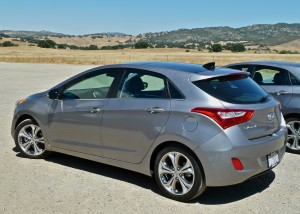
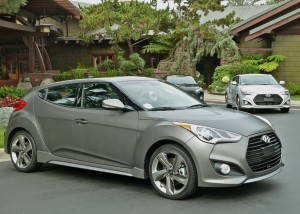
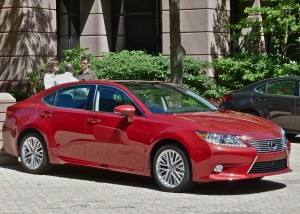
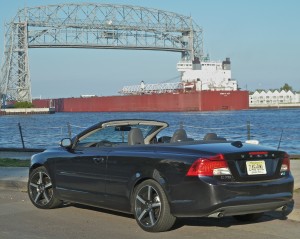
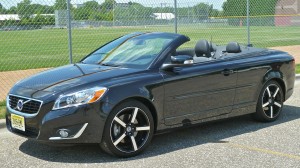
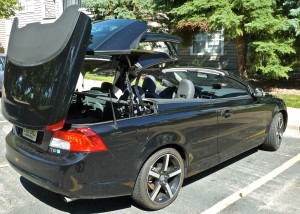
 John Gilbert is a lifetime Minnesotan and career journalist, specializing in cars and sports during and since spending 30 years at the Minneapolis Tribune, now the Star Tribune. More recently, he has continued translating the high-tech world of autos and sharing his passionate insights as a freelance writer/photographer/broadcaster. A member of the prestigious North American Car and Truck of the Year jury since 1993. John can be heard Monday-Friday from 9-11am on 610 KDAL(www.kdal610.com) on the "John Gilbert Show," and writes a column in the Duluth Reader.
John Gilbert is a lifetime Minnesotan and career journalist, specializing in cars and sports during and since spending 30 years at the Minneapolis Tribune, now the Star Tribune. More recently, he has continued translating the high-tech world of autos and sharing his passionate insights as a freelance writer/photographer/broadcaster. A member of the prestigious North American Car and Truck of the Year jury since 1993. John can be heard Monday-Friday from 9-11am on 610 KDAL(www.kdal610.com) on the "John Gilbert Show," and writes a column in the Duluth Reader.